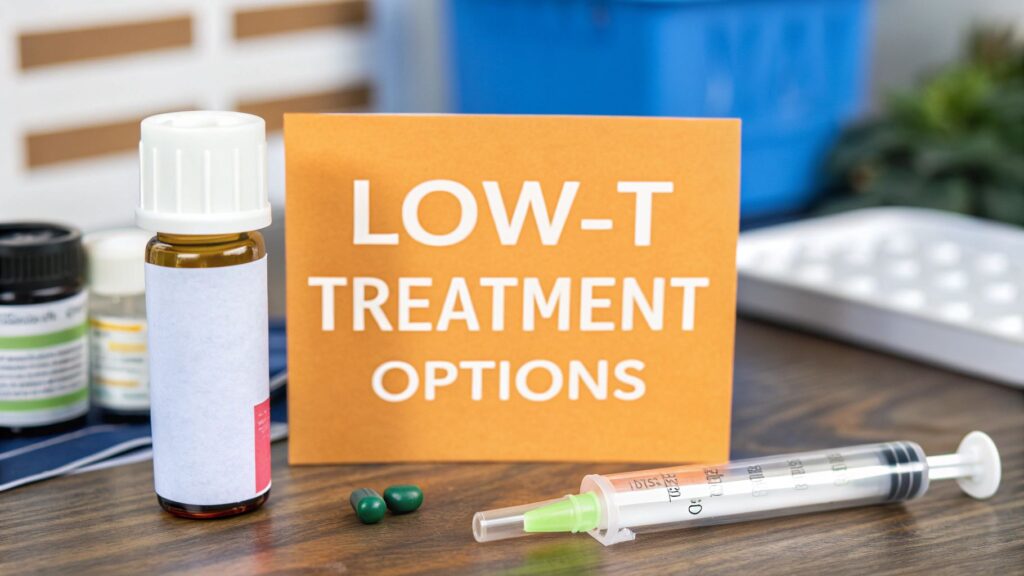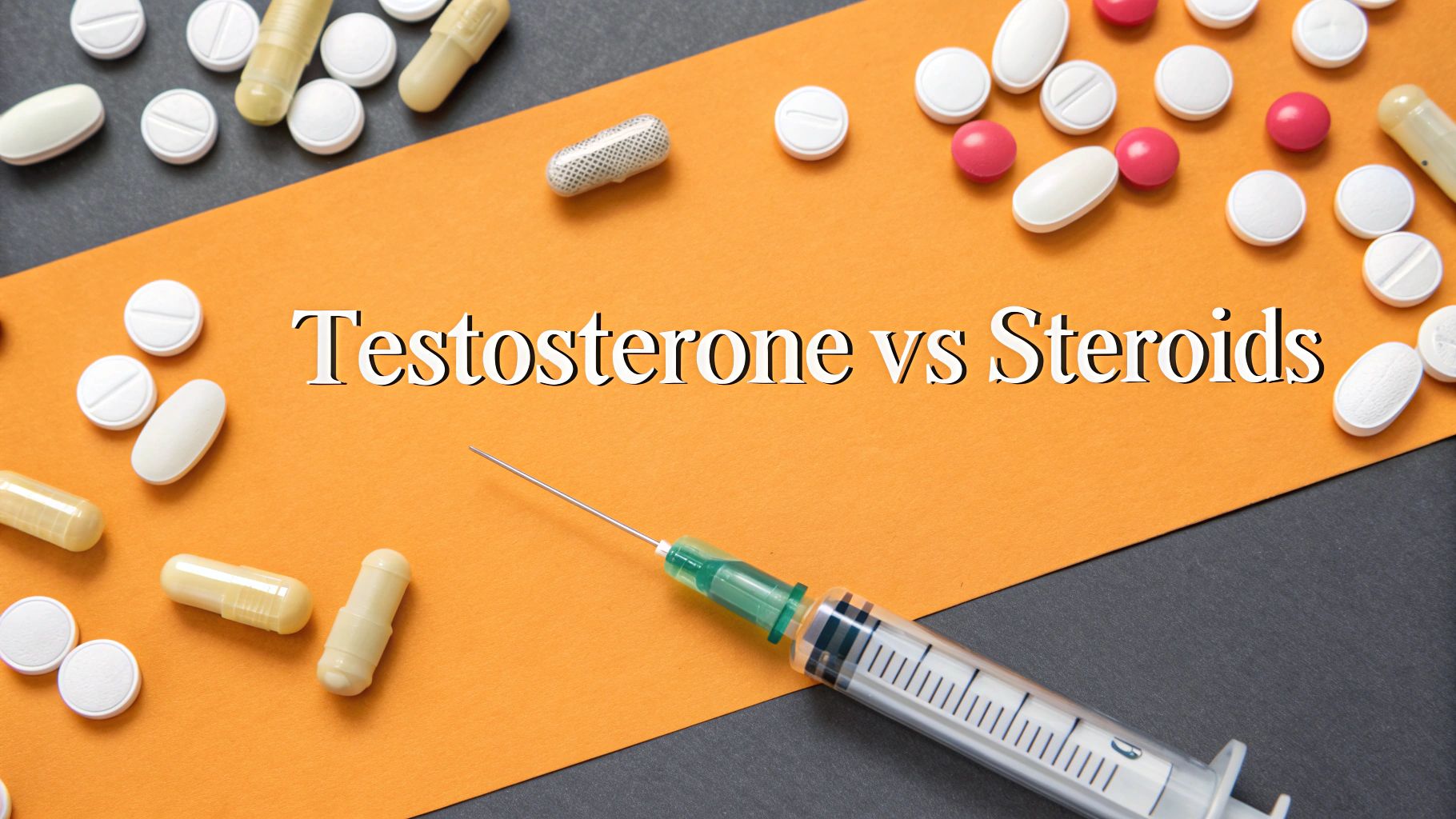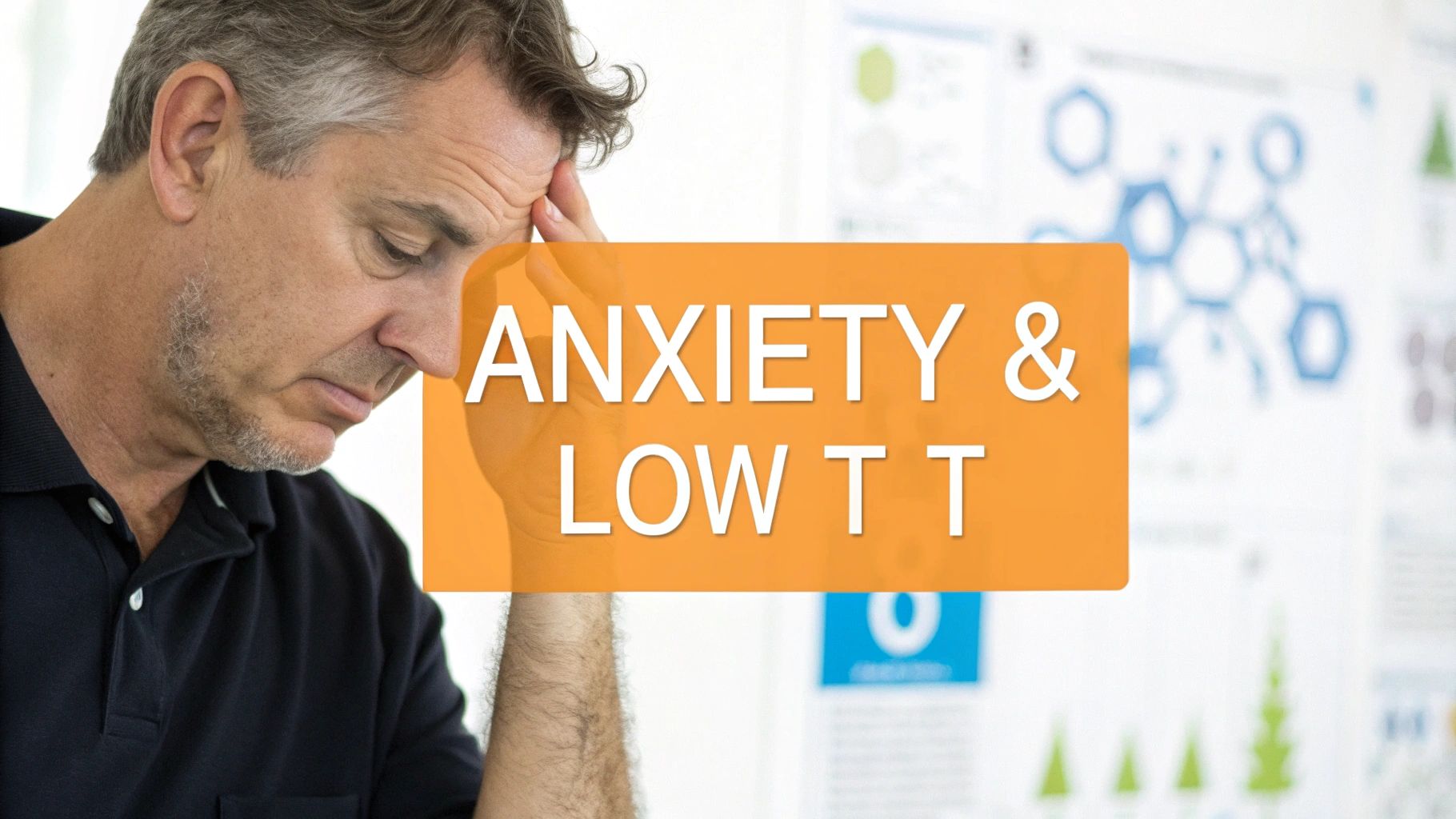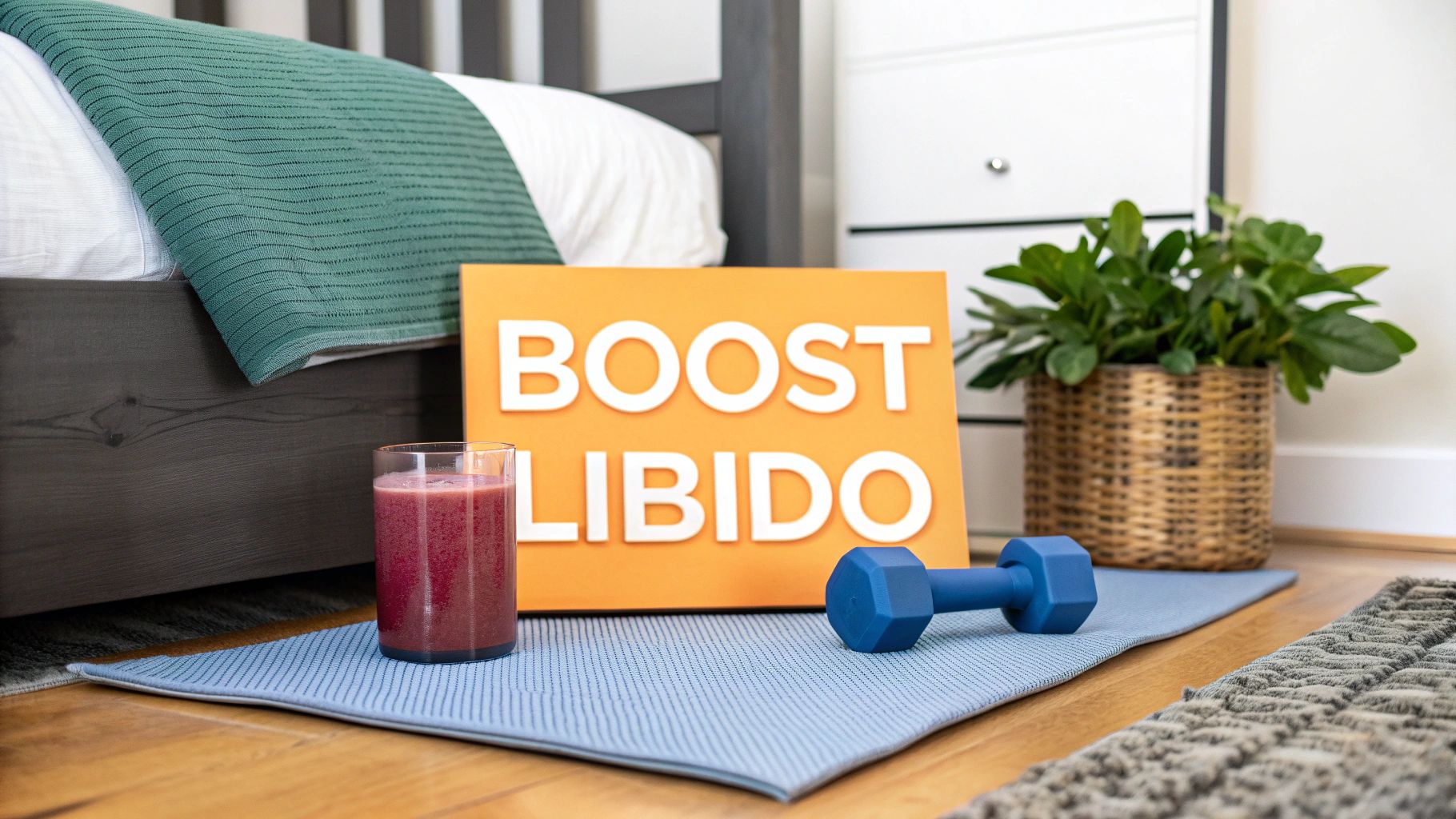Low Testosterone Treatment Options A Complete Guide

When you're dealing with low testosterone, the first thing to know is that you have options. The primary approach is Testosterone Replacement Therapy (TRT), which comes in several forms like injections, daily gels, and long-acting pellets. But medical treatments are only one part of the picture; lifestyle changes focusing on diet, exercise, and sleep are just as critical for managing symptoms and feeling your best.
Understanding Your Low Testosterone Treatment Options
Figuring out the right treatment for low testosterone, or hypogonadism, can feel like a lot to take in at first. The main goal is simple: get your hormone levels back into a healthy range to tackle symptoms like nagging fatigue, a nonexistent libido, and losing muscle mass.
The journey always starts with a proper diagnosis from your doctor. This isn't based on guesswork—it requires blood tests to confirm your testosterone is below the clinical threshold of 300 nanograms per deciliter (ng/dL).
Choosing the right path isn't a one-size-fits-all deal. It’s a conversation between you and your doctor, weighing your lifestyle, what you're comfortable with, and your ultimate health goals. As more men get diagnosed with hypogonadism, the demand for effective treatments has grown significantly.
In fact, the global market for testosterone replacement therapy hit USD 2.04 billion in 2024 and is expected to climb to USD 2.1 billion by 2025. This isn't just a trend; it reflects a real need for solutions that work. You can get more details from this testosterone replacement therapy market overview.
To make your initial research a little easier, let's break down the main options at a high level.
Quick Comparison of Low T Treatment Options
Before we get into the weeds, this table gives you a quick snapshot of the primary TRT methods. Think of it as a cheat sheet to help you grasp the key differences at a glance.
| Treatment Type | Administration Method | Dosing Frequency | Best Suited For |
|---|---|---|---|
| Injections | Intramuscular injection | Weekly or bi-weekly | Guys looking for the most cost-effective and powerful option who are comfortable with needles. |
| Gels/Patches | Topical application to the skin | Daily | Men who prefer a non-invasive, needle-free routine and can stick to a daily schedule. |
| Pellets | Subdermal implant | Every 3-6 months | Anyone who wants a low-maintenance, "set-it-and-forget-it" approach to their treatment. |
| Lifestyle | Diet, exercise, sleep, stress | Ongoing / Daily | Men with borderline low T, or as a foundational strategy to support any form of TRT. |
This overview should give you a good starting point. Now, let's dive deeper into each of these low testosterone treatment options to see how they stack up.
Comparing Injectable Testosterone Therapies

When it comes to treating low testosterone, injectables are the old guard. For decades, they've been one of the most common and effective options on the table, offering a powerful and budget-friendly way to get your hormone levels back on track.
The method is straightforward: testosterone is administered directly into a muscle, usually the glute or thigh. This direct-to-bloodstream approach is potent because it completely bypasses the variables of skin absorption or digestive breakdown, ensuring a reliable and predictable dose every single time.
If you're considering injections, you’ll quickly run into two dominant players: testosterone cypionate and testosterone enanthate. They're like two sides of the same coin—chemically almost identical, but with subtle structural tweaks that change how your body processes them.
Cypionate vs. Enanthate: Which Is Right for You?
Both testosterone cypionate and enanthate are slow-release esters suspended in oil. In simple terms, they're designed to release testosterone gradually over several days. The main difference between them boils down to their half-life—the time it takes for half of the dose to be processed and eliminated by your body.
- Testosterone Cypionate: This version generally has a slightly longer half-life of around 8 days. For some guys, this can mean a more flexible injection schedule.
- Testosterone Enanthate: With a half-life of about 7 days, its performance is practically indistinguishable from cypionate's. Most men would never be able to tell the difference in how they feel.
Because they are so similar, the choice often comes down to your doctor’s preference or what’s readily available. Either way, you're typically looking at a weekly or bi-weekly injection schedule to keep your hormone levels stable.
The core trade-off with injectable therapies is balancing their unmatched affordability against the need to manage potential hormonal peaks and troughs. More frequent, smaller injections can help smooth out these fluctuations for a more consistent feeling of well-being.
Ideal Candidates for Injectable TRT
So, who is this treatment really for? Injectable testosterone is often a perfect fit for men who prioritize cost and are comfortable with self-administering after a bit of medical guidance.
Think about these scenarios:
- The Budget-Conscious Patient: Injections are almost always the most affordable form of TRT. This makes long-term treatment sustainable without creating a major financial headache.
- The Patient Seeking Maximum Efficacy: Direct intramuscular delivery provides a powerful and consistent dose, leading to reliable symptom relief without worrying about absorption issues.
- The Individual Comfortable with Needles: If the idea of a weekly or bi-weekly self-injection doesn’t faze you, this method offers a simple and highly effective routine.
However, the injection schedule can create a "rollercoaster" effect for some guys. You might feel a surge of energy and mood right after your shot, followed by a noticeable dip as you get closer to your next dose. This is a common issue, but it's manageable. Working with your doctor to fine-tune the frequency—often by splitting a weekly dose into two smaller injections—can make a world of difference in smoothing out those peaks and valleys. This optimization is a key part of making injectable TRT work for you.
Taking a Look at Daily Gels and Patches

For a lot of men, the idea of needles is a non-starter. That's where topical treatments like gels and patches come in. Instead of injections, these methods deliver testosterone straight through the skin, offering a completely non-invasive way to get your hormone levels back on track.
The routine is pretty simple. You apply a gel once a day to your shoulders, upper arms, or stomach, or stick a patch onto a clean, dry patch of skin. This daily ritual is designed to mimic your body's natural testosterone rhythm, which helps sidestep the hormonal highs and lows that some guys feel with weekly shots.
This steady, predictable approach is a huge plus for anyone who thrives on consistency. But that convenience comes with a very serious trade-off.
The Trade-Off: Convenience vs. Transference
The main draw of topicals is how easy they are. Working a quick application into your morning routine feels a lot less clinical and intimidating than self-administering an injection. It makes them a great option for anyone with a fear of needles or for guys just starting TRT who want to ease into it.
The flip side, however, is the very real risk of secondary transference. This is when the medication rubs off on someone else—your partner or your kids—through skin-to-skin contact. That accidental exposure can cause unintended and serious hormonal effects in women and children.
The real challenge with topical testosterone isn't just remembering to put it on every day. It's about being constantly mindful of how you interact with your loved ones to prevent accidental exposure. It demands a level of daily diligence that can't be overlooked.
To avoid this, you absolutely have to:
- Wash your hands with soap and water right after you apply it.
- Let the gel dry completely before you put a shirt on.
- Keep the application site covered with clothing at all times.
- Avoid skin-to-skin contact with others at the application area.
For anyone living with family, these precautions are non-negotiable. Your lifestyle and home environment become the deciding factor in whether this treatment is a practical choice.
Who Is the Ideal Candidate for Gels or Patches?
Topical treatments are a perfect fit for some guys and a poor choice for others. A man who appreciates a daily routine and lives in a low-contact environment—maybe living alone or with a partner who understands the precautions—could find gels to be the ideal solution. They're also an excellent entry point for men who are hesitant about more invasive methods.
On the other hand, a father with young kids who love to climb on him or anyone in a very physically close relationship might find the transference risk too stressful to manage. Plus, some men develop skin irritation, rashes, or redness from the alcohol in the gels or the adhesives in the patches, which would obviously make this option unsuitable.
The demand for these convenient options is on the rise. The total Testosterone Replacement Therapy (TRT) market was valued at roughly USD 1.89 billion in 2024 and is projected to hit USD 2.70 billion by 2032, largely because more men are being diagnosed with hypogonadism. This growth shows a real need for different delivery methods that suit different lives. You can read more about the growth of the TRT market to see the trends.
Ultimately, choosing a topical treatment is about embracing both the daily convenience and the daily responsibility that comes with it.
Taking a Closer Look at Long-Acting Testosterone Pellets

What if you could handle your TRT just a few times a year instead of every day or week? That’s the core appeal of testosterone pellets. If the idea of daily gels or regular injections feels like one more thing to add to your already packed schedule, pellets offer a compelling, long-acting alternative.
The entire approach is built on a "set-it-and-forget-it" philosophy, providing a steady, consistent stream of testosterone without you having to think about it.
The process involves a quick, minor procedure right in your doctor's office. A provider implants several small, rice-sized pellets just beneath the skin, usually in the hip or gluteal area. These tiny implants are made of crystalline testosterone designed to dissolve very slowly, releasing the hormone at a stable rate for anywhere from three to six months.
For many guys, this completely eliminates the daily mental load of TRT, making it an incredibly convenient and hassle-free choice.
Who Is the Ideal Candidate for Pellets?
Testosterone pellets are a fantastic fit for men whose lifestyles make frequent dosing a genuine hassle. This isn’t about being lazy; it's about practicality. The treatment appeals most to guys who value consistency and convenience above all else.
Think about these real-world scenarios:
- The Busy Professional: For the guy who travels constantly for work, juggling gels, needles, and syringes through airport security is a significant burden. Pellets take all of that off the table.
- The Forgetful Individual: Let's be honest—not everyone is great at sticking to a strict medication schedule. If you're the type to forget your morning gel or miss an injection day, pellets ensure your treatment stays on track without any effort.
- The Needle-Averse Patient: While pellets do require an initial procedure, it replaces dozens of self-injections over the following months. For anyone with a real fear of needles, this trade-off is a huge win.
The real magic of testosterone pellets is their ability to deliver stable, long-term hormone levels with almost zero patient involvement. Once they're in, the therapy works silently in the background, freeing you from the day-to-day logistics of treatment.
Understanding the Downsides
But that convenience comes with a major trade-off: inflexibility. This is the critical point to understand. Once those pellets are implanted, your dose is locked in. You can't just decide to use a little less next week if you feel some side effects creeping in, the way you could with gels or injections.
The only way to change the treatment is to wait for the pellets to fully dissolve or, in very rare cases, have them surgically removed. This makes getting the initial dose right absolutely essential and requires a deep, careful consultation with your provider from the start.
There's also a small risk of infection at the insertion site or something called "pellet extrusion," where a pellet works its way back out of the skin. Ultimately, for the right person, pellets are a game-changer. But you have to be comfortable with the commitment to a fixed dose for several months at a time.
Foundational Lifestyle and Natural Support
While medical treatments like testosterone injections and gels are powerful tools for correcting low T, they don’t work in a vacuum. Your daily habits create the backdrop for your therapy, determining whether it delivers good results or great ones. Think of lifestyle changes not as a substitute for clinical TRT, but as a critical partner in your overall hormonal health plan.
Making simple, consistent adjustments can have a surprising impact on how you feel and how well your treatment works. It’s all about getting your body’s natural processes to support the heavy lifting your therapy is doing.
Core Pillars of Natural Support
Making a real difference starts with locking in four key areas. These aren’t just generic wellness tips; they are backed by evidence and have a direct line to your hormonal balance and vitality.
- Strength Training: Hitting the weights, especially with big compound movements like squats and deadlifts, is one of the best ways to naturally signal your body to produce testosterone. It also helps you build back the lean muscle mass that low T often steals away.
- Sleep Optimization: Your body does some of its most important hormone production while you sleep. Getting a solid 7-9 hours of quality, uninterrupted sleep each night is one of the most powerful things you can do for your hormonal health. No supplement can replace it.
- Strategic Nutrition: A diet loaded with lean proteins, healthy fats, and key micronutrients like zinc and vitamin D gives your body the raw materials it needs for hormone synthesis. You can dive deeper into these foundational strategies in our guide to the secrets of boosting testosterone levels science-based.
- Stress Management: Chronic stress is a testosterone killer. It floods your system with cortisol, a hormone that actively shuts down T production. Finding ways to decompress, whether through meditation or just carving out dedicated downtime, helps lower cortisol and lets your T levels breathe.
The table below provides a quick overview of how these lifestyle factors influence your body's natural testosterone production.
Lifestyle Factors Impacting Testosterone
An overview of evidence-based lifestyle modifications and their potential impact on natural testosterone production and overall well-being.
| Lifestyle Factor | Primary Action | Scientific Backing | Practical Tip |
|---|---|---|---|
| Resistance Training | Stimulates acute testosterone and growth hormone release; improves body composition. | Well-documented in numerous studies to increase androgen receptor sensitivity and T levels post-exercise. | Focus on multi-joint, compound exercises (squats, deadlifts, bench press) 3-4 times per week. |
| Sleep Quality | Majority of testosterone production occurs during REM sleep. | Studies show T levels can drop by 10-15% after just one week of restricted sleep (5 hours/night). | Aim for 7-9 hours of consistent sleep. Create a dark, cool room and avoid screens before bed. |
| Nutrition | Provides essential building blocks (zinc, vitamin D, healthy fats) for hormone synthesis. | Deficiencies in key nutrients are directly linked to lower testosterone levels. | Eat a balanced diet with lean proteins, healthy fats (avocado, nuts), and zinc-rich foods (oysters, beef). |
| Stress Reduction | Lowers cortisol, a hormone that directly inhibits testosterone production. | High cortisol levels are shown to have an inverse relationship with testosterone. | Incorporate daily stress-management practices like meditation, deep breathing, or even a 20-minute walk. |
These pillars form the non-negotiable foundation for supporting any TRT protocol.
The Role of Natural Testosterone Boosters
As more men become aware of low T, the market for over-the-counter "testosterone boosters" has exploded. These supplements typically contain a blend of herbs, vitamins, and minerals that claim to raise testosterone naturally. While a few ingredients might have some limited evidence behind them, this is an industry that requires a healthy dose of skepticism.
It's crucial to view lifestyle changes as the primary natural support for your TRT. Supplements can be considered, but only after a thorough discussion with your doctor to ensure they are safe, effective, and won't interfere with your prescribed treatment.
The testosterone booster market is massive, valued at around USD 5.5 billion in 2025 and projected to swell to nearly USD 9.7 billion by 2035. This growth shows how much interest there is, but it also highlights the need for caution. The supplement industry is notorious for regulatory loopholes, product safety concerns, and counterfeit goods.
Before you even think about adding a supplement to your routine, your first and only move should be to talk to your healthcare provider. Their guidance is essential for making safe, informed decisions that truly complement your low testosterone treatment.
How To Choose The Right TRT For You
Picking the right low testosterone treatment from all the available options can feel overwhelming. But it really comes down to a straightforward conversation with your doctor about your lifestyle, your priorities, and what you’re comfortable with. There’s no single “best” method—the right choice is the one that fits seamlessly into your life and helps you hit your specific health goals.
For example, if you’re someone who can't stand needles, injectables are obviously off the table. Daily gels or long-acting pellets would make a much more practical starting point. On the other hand, if your goal is to find the most direct and powerful therapy, the simple routine of a weekly injection might feel like the most efficient and effective path forward.
Cost is another huge piece of the puzzle. While pellets offer incredible, set-it-and-forget-it convenience, they also come with a higher upfront investment. Before you commit, you need to understand the full financial picture. Our guide on the average cost of testosterone replacement therapy can help you get a handle on your budget.
Matching Treatment To Your Profile
Your unique situation is the most important factor here. To make things a bit clearer, let's look at a few common patient profiles and see which treatments line up best. This should give you a better idea of where you might fit.
-
The Needle-Averse Patient: Daily gels or patches are the obvious choice. They deliver a steady, consistent dose of hormones without the anxiety of self-injection. The trade-off is that you have to commit to a daily routine and be extremely careful about preventing transference to others.
-
The Budget-Conscious Individual: Injectable testosterone is almost always the most affordable TRT option out there. It delivers potent results without breaking the bank, making it a sustainable long-term solution for most guys.
-
The Busy Professional: For anyone with a hectic travel schedule or who just wants to think about their treatment as little as possible, testosterone pellets are a total game-changer. Their "set-it-and-forget-it" nature offers convenience you just can't beat, requiring only a couple of doctor visits each year.
This decision tree gives you a simple framework for starting the conversation with your doctor, based on how severe your symptoms are and your age.

As the visual shows, milder symptoms are often addressed with lifestyle changes first. But when symptoms become more significant, it’s time to consider TRT, with different options being more suitable at different stages of life.
Common Questions (And Honest Answers) About TRT
Starting Testosterone Replacement Therapy is a big step, so it’s natural to have questions. Getting straightforward answers about the practical side of things—from side effects to results—is the best way to feel confident as you work with your doctor.
Let's clear up some of the most common things men ask before beginning their journey back to hormonal balance.
What Are The Common Side Effects Of TRT?
While TRT is very safe when managed by a medical professional, it’s not without potential side effects. The good news is that most are mild and easy to manage. You might notice things like acne or oily skin, almost like a throwback to your teenage years.
Some men also experience a bit of fluid retention, especially around the ankles. A more serious concern, however, is an increase in red blood cell count (a condition called polycythemia), which can raise the risk of blood clots if it goes unchecked. This is exactly why ongoing medical supervision isn't just a suggestion—it's essential. Regular lab work ensures we catch any issues early. You can learn more about this in our guide on why TRT monitoring is important.
How Long Until I See Results?
This is a marathon, not a sprint. While you might start feeling better pretty quickly, the physical changes take time. Improvements in libido, mood, and energy often show up within the first 3 to 6 weeks.
The more visible results, like an increase in muscle mass and a drop in body fat, take longer to appear. You'll typically start seeing those changes become more obvious after 3 to 6 months of consistent therapy. Of course, every man’s body is different, so your personal timeline will depend on your own physiology and the treatment method you’re using.
The point of TRT isn’t an overnight fix; it’s about a steady, sustainable return to feeling like yourself. Consistency and open communication with your doctor are what truly drive long-term success and relief from your symptoms.
Can I Stop TRT Once I Start?
Stepping away from TRT is a major medical decision that you should never make on your own. When you’re on therapy, your body’s natural testosterone production slows way down. If you stop suddenly, it can take a while for your system to reboot.
This often means your original low T symptoms will come rushing back, sometimes even worse than before. If you and your doctor decide to stop, it must be done with a specific protocol designed to help restart your natural hormone production as effectively as possible.
At Elite Bioscience, we provide the expert guidance and high-quality therapies needed to navigate your treatment journey safely and effectively. Explore our tailored TRT programs and take the first step toward reclaiming your vitality.
QUICK SEARCH
Make an account today to start your journey towards a better and healthier lifestyle.






